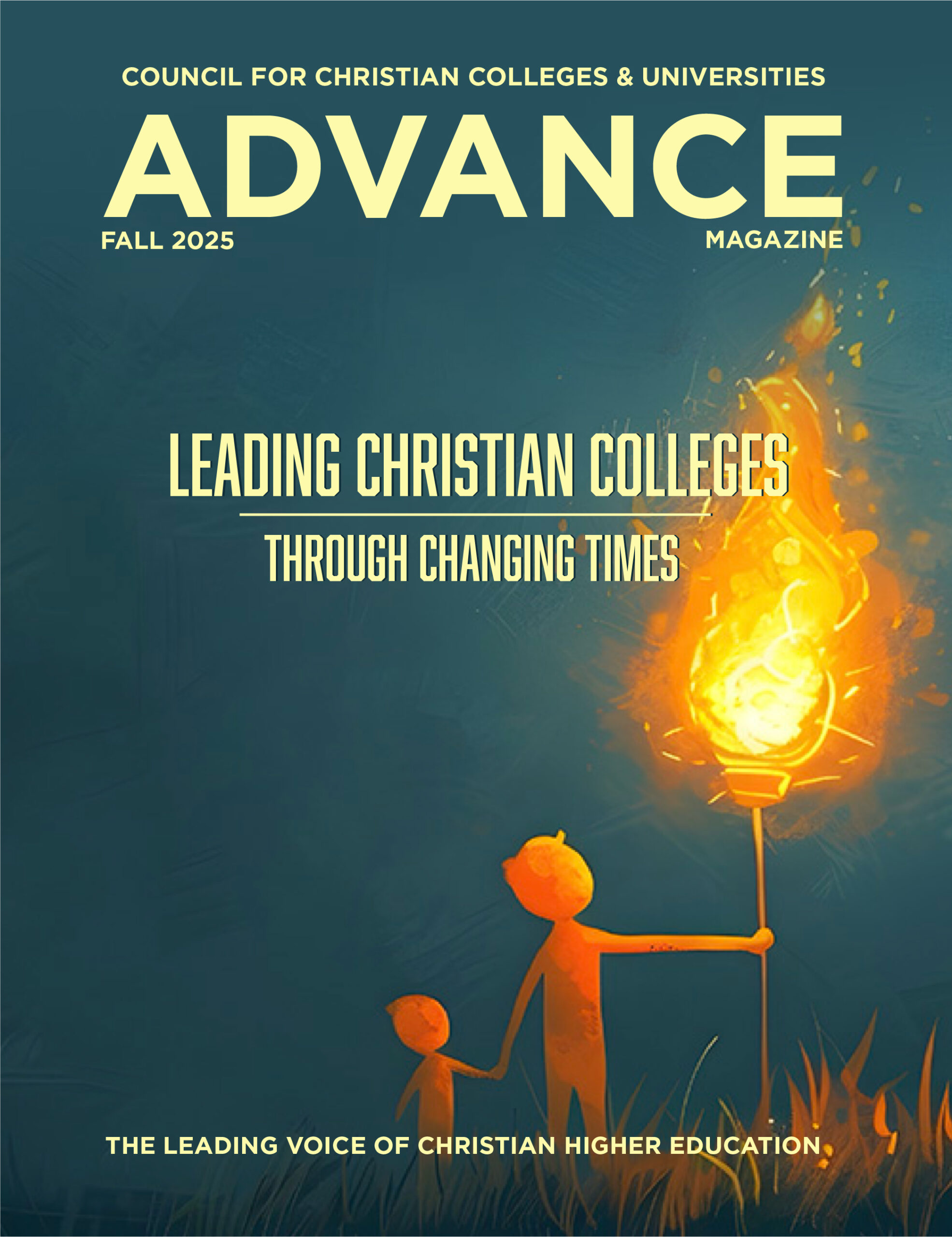Magazine

Christian higher education stands on shifting sand—as does the entire higher education sector. In the face of changing demographics, economic challenges, increasing competition, and shifts in Americans’ religious affiliation, Christian colleges and universities face new and unexpected obstacles… alongside opportunities for innovation.
The Headwinds Christian Colleges Face
For years, colleges and universities have been bracing for the “enrollment cliff”—a sharp drop in the college-aged population due to declining birth rates, expected to hit college campuses in the next five to 10 years. More colleges and universities will be competing for fewer students, and institutions’ survival may depend on their ability to sustain enrollment.
Christian colleges and universities face an additional challenge, with an even narrower enrollment funnel. Beyond declining birth rates, the United States has seen a decline in the number of families identifying with religious faith over the past 50 years. According to a January 2024 report from the Pew Research Center, 28% of American adults now identify as religious “nones”—individuals unaffiliated with any organized religion. This number increased over several decades In 2007, “nones” made up only 16% of the American population. This data tracks with similar research from a September 2022 Pew report, which notes a substantial decline in the number of American Christians. In 1972, 90% of U.S. adults described themselves as Christian. By 2021, that number had dropped to 63%. Fewer Christian families naturally means that fewer prospective students will consider faith-based colleges and universities.
Demographics is just one factor impacting enrollment. Higher education also faces challenges in the form of public perception. In a July 2024 article, Gallup shared the results from a recent survey on Americans’ confidence in various institutions. Gallup found that only 31% of American adults believe higher education is headed in the right direction. Many prospective students are considering alternatives to a four-year college education. According to a 2021 joint survey by the Carnegie Corporation of New York and Gallup, 46% of American families are interested in alternative pathways for their high-school students, including community college, trade schools, the military or employment that does not require additional schooling. In the years to come, the U.S. will have fewer college-aged students, and increasing numbers from that diminished pool may choose not to enroll in college.
These strains on enrollment leave many colleges and universities with a significant challenge—especially small institutions without an endowment, which are particularly dependent on tuition revenue. Recent years have seen increased rates of college closures, and a December 2024 working paper by the Federal Reserve Bank of Philadelphia predicts that the rate of closures will increase based on the predicted decline in enrollment. In the last seven years, among Christian colleges and universities that have closed, average income had decreased by 35%—with a particularly sharp drop in income from tuition and fees, which had decreased by 46%. Other predictive indicators showed that average expenditures among this class of institutions declined by 13%; average budgetary deficit increased from $646,000 to $3.86 million; undergraduate enrollment declined by 78%; graduate enrollment declined by 33%; and the average number of employees declined by 38%. For these institutions, closure followed an often-rapid descent.
These schools faced many constraints which made it even harder to overcome financial obstacles. Many of the Christian campuses that closed shared certain characteristics: high, fixed campus operating costs, spiraling insurance benefits, fewer undesignated endowment gifts, lack of liquidity and creditworthiness, a downtick in bond rating, rising average student and family tuition debt burden, and increasing default rates.
To overcome these constraints and avoid the downward plummet that leads to closure, Christian colleges and universities must seize upon this season as an opportunity to innovate, finding creative new ways to meet needs while retaining the unique qualities of a faith-filled education.
New Opportunities for Innovation
Remarkably, several smaller, aspiring Christian colleges and universities have discovered constructive, profitable alternatives to complicated, involuntary takeovers. For these institutions, connecting with the right students, crafting relationships with the community, and identifying partnerships with mission-aligned organizations provide new opportunities to survive and flourish.
If declining religiosity in America is one challenge facing Christian colleges and universities, Ilana Horwitz offers some encouraging insights in “God, Grades, and Graduation.” While Horwitz confirms that the number of “nones” is growing, she notes that “the percentage of Americans who are deeply religious has not budged.” She quotes a 2017 study by Landon Schnabel and Sean Bock, who note that “only moderate religion is on the decline in the U.S.” It is from this category of the “moderately religious” that the “nones” emerge. Horwitz also discovered in recent studies that geography — specifically among various states — is a major factor. Several states are much more devoutly religious than others. These findings offer both hope and opportunity to Christian institutions, who may focus their attention on the steady category of deeply religious Americans — those most inclined to consider an education shaped by Christian faith — and strategically consider geography in their recruitment efforts.
Christian colleges and universities thrive by adapting while remaining true to their mission of Christian higher education, which is grounded in a holistic, faith-based education. Christian colleges and universities seek to develop the mind, heart, and soul, forming students who are both knowledgeable and wise, equipped to make a difference for the common good as redemptive voices in the world. This mission integrates core Christian values, ethics, and faith across the classroom, athletic fields, chapels, and dormitories.
Christian institutions are poised to carve a new niche by looking downstream to K-12 Christian private and charter schools, which provide a similar emphasis on Christian values and spiritual formation alongside rigorous academic learning. According to the U.S. Department of Education, 3.7 million students were enrolled in a K-12 religious private school as of fall 2021. Many of these schools share Christian colleges’ approach to a holistic, faith-based education. Early college initiatives can provide Christian higher education with a significant enrollment marketing opportunity through the early character education on offer at these institutions. Through their shared vision, these K-12 schools serve as early Christian colleges, offering students an experience of the transformative, faith-based education they will find at Christian colleges and universities.
Beyond opportunities in enrollment, Christian colleges and universities can seize on new avenues for partnership by creating regional Christian higher learning consortia that utilize resource- and program-sharing benefits. For instance, the CCCU Online Course Sharing Network, powered by Acadeum, is a consortium that has expanded to include more than 80 CCCU institutions since its inception in 2018. The network allows participating institutions to share online courses and develop new programs without significantly raising costs. In the past year alone, CCCU institutions have facilitated over 4,000 shared enrollments, resulting in more course options for students and expanded offerings for institutions. Collective procurement is one example of how colleges and universities can collaborate to reduce future costs while providing enhanced opportunities for students.
Small Christian colleges and universities can also find new methods for academic partnerships through a range of methods, such as collaborative and joint degree programs, rotating semesters, course cross-registration, and coordinated pre-college camp opportunities. These bulk rate discounts, scalable services, and data solutions can help cross-subsidize revenue streams to lessen the burden on traditional tuition.
One example is the partnership between Mid-America Christian University (MACU) in Oklahoma and Warner Pacific University (WPU) in Oregon to offer an expanded ministry program. This partnership allows WPU students to access MACU’s online ministry program, earning undergraduate and graduate degrees in Christian ministries and ministry leadership.
Rather than addressing challenges by assuming more risk, which may fix a temporary problem but is not recommended as a long-term solution, Christian colleges and universities also have the opportunity to foster community partnerships that share resources, cross-subsidize efficiencies, and outsource or co-source talent acquisition. For example, Malone University in Ohio established the “Learn and Earn” initiative, which partners with organizations like Fastenal Company, Visit Canton, and Jarrett Logistics Systems to offer experience in a professional workplace setting. According to Malone, “At the end of each semester, partners can also make an additional contribution that will be put towards the student’s bill for attendance. This is an excellent opportunity for students to gain valuable experience and earn money towards their education.”
Through such partnerships, college students can gain funding for tuition and strengthen their path to employment, while the universities gain a mutually beneficial partnership which provides financial support and strengthens students’ academic experience.
As Christian colleges face new challenges, they also embrace opportunities, ideas, and partnerships in order to survive and thrive long into the future.
__________
David A. Hoag, Ph.D., serves as the eighth president of the CCCU. James E. Samels, Ed.D. is the Founder and Chief Executive Officer of The Education Alliance and The Samels Group. Amanda Staggenborg, Ed.D. serves as the Director of Communications and Engagement at Mount Angel Abbey.

